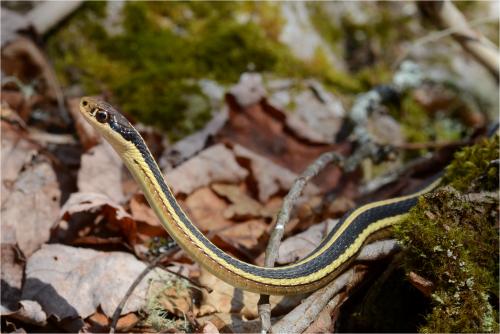
Scientific name:Thamnophis saurita
Mi’kmaq Translation: Translation Unknown
French Translation: Couleuvre mince de l’Est
Gaelic Translation: Nathair-ribein tuath
Physical Description
Visually, ribbon snakes resemble garter snakes but are smaller and slenderer. They are dark brown or black in colour, and have three yellow stripes. One stripe goes down the back (dorsal) and one on each side (lateral). There is a white crescent in front of the eye, a white chin, a whitish yellow belly and rust-coloured sides.
Size:
Young ribbon snakes measure 16 – 24cm long
Adult males measure 28 – 40cm long
Adult females measure 29 – 50cm long
Range and Distribution
Ribbon snakes have two separated populations in Canada. The larger population is in southern Ontario and a small portion of Quebec, and the second, smaller population in Nova Scotia. They have a limited range and population in Nova Scotia and are found mainly in the regions of Queens County and Lunenburg County.
Habitat
These semi-aquatic snakes live in wetlands, and boggy or grassy places along the shorelines of lakes and rivers. They also rely on forested areas for overwintering and birthing sites. Overwintering is often communal and occurs below the frost line in mammal burrows, rock crevices and muskrat lodges.
Diet
They predate primarily on amphibians, mainly frogs, as well as small fish and insects.
Reproduction and Life Cycle
Ribbon snakes breed in the spring after hibernation. Females give live birth of up to 15 babies in late summer. Juveniles reach maturity in two to three years. Longevity is uncertain but estimated to be approximately 11 years.
Status
NSESA: Threatened (Atlantic Population)
COSEWIC: Threatened (Atlantic Population)
Threats
Road mortality and the loss of wetland habitat pose significant threats to the ribbon snake population. Additionally, severe impacts from pollution and agricultural runoff are causing declines in amphibian populations, which is a key food source for the ribbon snake.